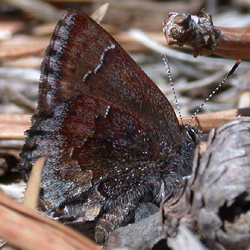Find a Butterfly
Hoary Elfin
Callophrys polios
Named
Cook & Watson, 1907

Identification
Wingspan: 3/4-1". Can be told from other elfins by the extent of gray "hoary" shading along outer edge of wings beneath. Only the Hoary Elfin has gray along the outer edge of the forewing beneath. Gray shading on hindwings much more extensive than in other elfins, covering outer third of hindwing. Compare especially Frosted Elfin.
Distribution
Eastern Alaska southeastward through central Canada to northern Ontario and Nova Scotia; south to northern tier of states and extending further south in Rockies to New Mexico and in Appalachians to Virginia. In New England, occurs north to central Vermont, northern New Hampshire, and central Maine.
Status in Massachusetts
Massachusetts Hoary Elfins are limited to dry sandy or rocky regions in which the food plant, Bearberry (Arctostaphylus uva ursi) grows. The species occurs with some frequency in Barnstable and Plymouth Counties; very local or overlooked elsewhere in the Commonwealth. Historically confused with other elfins. Farquhar thought Waltham and Cape Cod records were "probably correct". One record from Martha‘s Vineyard. Maximum: 27, Plymouth (Plymouth Co.), 19 May 1992.

Flight Period in Massachusetts
Single flight, typically late April to mid May. Extreme dates: 26 April 1991, Plymouth (T. Dodd and B. Cassie) and 23 May 1994, Plymouth (Plymouth Co.), R. Walton, R. Forster, D. Diggins.
Larval Food Plants
Bearberry (Arctostaphylus uva ursi) is the only documented food plant, though Trailing Arbutus (Epigaea repens) is possibly an alternative at some sites.
Adult Food sources
Bearberry and blueberry flowers are primary nectaring sources and were the only flowers noted during the Atlas period.

Habitat
On, over, or very near the food plant, which grows in sandplains and rocky uplands.
Life Cycle
EGG: Greenish white; turban shaped. OVIPOSITION: Eggs laid singly, on or near flower buds of host plant. LARVA: Slug-shaped; early instar larvae are yellowish-green and blend with the host plant flowers; more mature larvae, feeding after the flowers have faded, are darker green and camouflaged on the Bearberry foliage. CHRYSALIS: Light to dark brown and rounded. OVERWINTERING STAGE: Chrysalis.
Account Author
Brian Cassie



